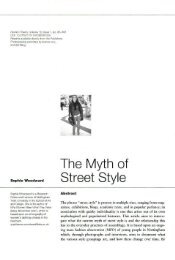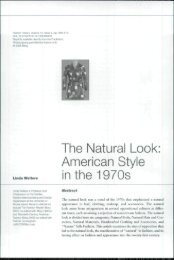Spinning the Ephemeral PDF - SMU Fashion Media
Spinning the Ephemeral PDF - SMU Fashion Media
Spinning the Ephemeral PDF - SMU Fashion Media
You also want an ePaper? Increase the reach of your titles
YUMPU automatically turns print PDFs into web optimized ePapers that Google loves.
290 Fiona Anderson<br />
Figure S<br />
Middie-class Edinburgh family<br />
photographed c. 1890. The<br />
fa<strong>the</strong>r is a butcher and he is<br />
wearing a tweed suit. Courtesy<br />
of <strong>the</strong> Trustees of <strong>the</strong> National<br />
Museums of Scotland,<br />
production into three main categories.^ Tweeds, which for example are<br />
predominantly dark gray, with only subtle surface patterning might be<br />
categorized as mainly showing a relationship with exclusively urban<br />
contexts and activities (Breward 1999: 40). In contrast to this, articles in<br />
<strong>the</strong> Tailor and Cutter, along with contemporary sartorial etiquette books<br />
and photographs of people taking part in sport, suggest that bold checked<br />
patterns and homespuns were primarily sporting cloths to be worn in <strong>the</strong><br />
country {The Major 1900: 19-21; Tailor and Cw^fer January 17 1901;<br />
Lambert 1991). Tbe third category, which from <strong>the</strong> evidence studied<br />
appears to be <strong>the</strong> largest, occupies a more ambiguous space, consisting<br />
of a diverse range of cloths that according to <strong>the</strong> specifics of each design,<br />
sbow a relationship with both rural and urban landscapes. These ambiguities<br />
of landscape are linked to <strong>the</strong> fact that rural and urban contexts, were<br />
deeply intertwined in <strong>the</strong> processes of manufacturing, designing, promoting,<br />
and selling tweed cloth.<br />
IWeed in Rural and Urban Contexts<br />
The Scottish tweed industry was mainly located in <strong>the</strong> Borders region,<br />
which is primarily rural and o<strong>the</strong>r significant tweed tnills of <strong>the</strong> period,<br />
such as Johnstons of Elgin and Crombies of Grandholm and Cothal, were<br />
similarly located in rural Fiighland areas. Fiowever, many of <strong>the</strong> leading<br />
cloth merchants who acted as intermediaries between <strong>the</strong> tweed manufacturers<br />
and tailors were based in London, thus forming a vital source<br />
of communication and feedback about which designs were selling most<br />
successfully (Fiarrison 1995: 49-51).<br />
John Allan in his book Cromhies of Grandholm and Cothal 1805-<br />
1960 discusses tbe role of James Locke <strong>the</strong> Regent Street tailor in expanding




